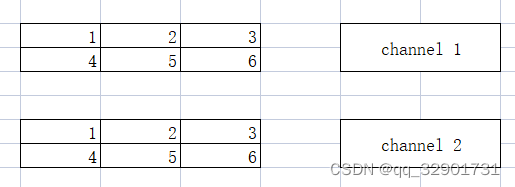自制深度学习推理框架-第十一节-再探Tensor类并准备算子的输入输出
本课程介绍
我写了一个《从零自制深度学习推理框架》的课程,课程语言是 C++,课程主要讲解包括算子实现和框架设计的思路,国内算是独一份,目前已登上 HelloGithub 最新一期。我这个仓库算是课程的上游项目,根据上游项目来规划课程内容。
b 站视频链接: https://space.bilibili.com/1822828582
github 链接: https://github.com/zjhellofss/KuiperInfer 欢迎点赞和 PR 已经发布 Docker
本节课代码
git clone https://github.com/zjhellofss/KuiperCourse
git checkout ten
再探张量类Tensor
自从我们第二节讲完Tensor之后,再也没有好好地看过Tensor这个重要的数据结构。如同本课程第二节所言,Tensor表示的是一个多维向量,用于存储模型的输入、输出以及各层权重等数据。
因此在第二节中我们编写的Tensor类其实并不能满足我们的使用需要,我们将在这一节以代码阅读的方式来看看一个完全版本的Tensor应该具备怎样的要素,同时我们对Tensor类的分析来看看在C++中一个设计好的类应该是怎么样的。
Tensor<float>::Tensor(uint32_t channels, uint32_t rows, uint32_t cols) {
data_ = arma::fcube(rows, cols, channels);
if (channels == 1 && rows == 1) {
this->raw_shapes_ = std::vector<uint32_t>{cols};
} else if (channels == 1) {
this->raw_shapes_ = std::vector<uint32_t>{rows, cols};
} else {
this->raw_shapes_ = std::vector<uint32_t>{channels, rows, cols};
}
}
在这里,raw_shape记录的是另外一个方面的形状信息,主要用于review和flatten层中。
举一个简单的例子,当Tensor将一个大小为(2,16,1)的Tensor reshape到(32,1,1)的大小时,raw_shapes变量会被记录成(32). 将一个大小为(2,16, 2)的Tensor reshape到(2, 64)的大小时,raw_shapes会被记录成(2,64).
那这样做的目的是什么呢?原来的Tensor不能在逻辑上区分当前的张量是三维的、二维的还是一维的,因为实际的数据存储类arma::fcube总是一个三维数据。
Tensor中的逻辑维度
我们通过raw_shapes来记录当前的实际维度,当raw_shapes的长度为2时,说明当前的张量是二维的。当raw_shapes的长度为1的时候,说明当前的张量是一维的。
这样一来,系统中就有两种类型的shape, 第一种shape是数据本身的维度,例如有一个大小为(32,1,1)的data,它的shapes就会是32x32x1, 但是对于raw_shapes这个数据对应的维度就是(32, ),这样一来,我们就可以在后续的推理知道data的逻辑维度是多少(现在是一个一维的张量).
列优先的Reshape
void Tensor<float>::ReRawshape(const std::vector<uint32_t>& shapes) {
CHECK(!this->data_.empty());
CHECK(!shapes.empty());
const uint32_t origin_size = this->size();
uint32_t current_size = 1;
for (uint32_t s : shapes) {
current_size *= s;
}
CHECK(shapes.size() <= 3);
CHECK(current_size == origin_size);
if (shapes.size() == 3) {
this->data_.reshape(shapes.at(1), shapes.at(2), shapes.at(0));
this->raw_shapes_ = {shapes.at(0), shapes.at(1), shapes.at(2)};
} else if (shapes.size() == 2) {
this->data_.reshape(shapes.at(0), shapes.at(1), 1);
this->raw_shapes_ = {shapes.at(0), shapes.at(1)};
} else {
this->data_.reshape(shapes.at(0), 1, 1);
this->raw_shapes_ = {shapes.at(0)};
}
}
我们再来分析一下这个函数,如果传入的shapes是1维的,就相当于将数据展开为(elem_size,1,1),并将逻辑维度赋值为1. 如果传入的shapes,相当于将数据展开为(shapes.at(0), shapes.at(1), 1). 我们来看看下面的这个图例:

它的大小是channel = 2, rows = 2, cols = 3,当前的raw_shapes等于(2,2,3) 如果将这个tensor调整到到一维的,那么就如下图所示:

当前的rawshapes等于(12),我们也就可以通过判断rawshapes的方式来得知当前的逻辑维度。我们可以看到Reshape的方式是列优先的,这是因为负责管理数据的armadillo::cube是一个列优先的容器。
行优先的Reshape
那如果我们在某些情况下需要行优先的Reshape呢?
void Tensor<float>::ReView(const std::vector<uint32_t>& shapes) {
CHECK(!this->data_.empty());
const uint32_t target_channels = shapes.at(0);
const uint32_t target_rows = shapes.at(1);
const uint32_t target_cols = shapes.at(2);
arma::fcube new_data(target_rows, target_cols, target_channels);
const uint32_t plane_size = target_rows * target_cols;
for (uint32_t c = 0; c < this->data_.n_slices; ++c) {
const arma::fmat& channel = this->data_.slice(c);
for (uint32_t c_ = 0; c_ < this->data_.n_cols; ++c_) {
const float* colptr = channel.colptr(c_);
for (uint32_t r = 0; r < this->data_.n_rows; ++r) {
const uint32_t pos_index =
c * data_.n_rows * data_.n_cols + r * data_.n_cols + c_;
const uint32_t ch = pos_index / plane_size;
const uint32_t row = (pos_index - ch * plane_size) / target_cols;
const uint32_t col = (pos_index - ch * plane_size - row * target_cols);
new_data.at(row, col, ch) = *(colptr + r);
}
}
}
this->data_ = new_data;
}
我们只能通过位置计算的方式来对逐个元素进行搬运, const uint32_t plane_size = target_rows * target_cols;来计算行数和列数相乘的积。
const uint32_t pos_index = c * data_.n_rows * data_.n_cols + r * data_.n_cols + c_; 得 到调整前的元素下标,随后我们计算调整后的通道下标位置:ch = pos_index / plane_size,同理计算row,col等调整位置后的行、列坐标。

可以通过图例看到原本的张量按照行优先的顺序完成了展开。
其他的辅助方法
TensorElementMultiply用于对两个张量逐点相乘,TensorElementAdd用于两个张量的相加,这类方法不做赘述,见名思意。
构建计算图关系
内容回顾
我们在回顾一下之前的内容,我们根据pnnx计算图得到了我们的计算图,我们的计算图由两部分组成,分别是kuiper_infer::RuntimeOperator和kuier_infer::RuntimeOperand.
但是作为一个计算图,计算节点之间往往是有连接的,包括从input operator到第一个计算节点再到第二个计算节点,直到最后的输出节点output operator,我们再来回顾一下这两个数据结构的具体定义:
struct RuntimeOperator {
int32_t meet_num = 0; /// 计算节点被相连接节点访问到的次数
~RuntimeOperator() {
for (auto ¶m : this->params) {
if (param.second != nullptr) {
delete param.second;
param.second = nullptr;
}
}
}
std::string name; /// 计算节点的名称
std::string type; /// 计算节点的类型
std::shared_ptr<Layer> layer; /// 节点对应的计算Layer
std::vector<std::string> output_names; /// 节点的输出节点名称
std::shared_ptr<RuntimeOperand> output_operands; /// 节点的输出操作数
std::map<std::string, std::shared_ptr<RuntimeOperand>> input_operands; /// 节点的输入操作数
std::vector<std::shared_ptr<RuntimeOperand>> input_operands_seq; /// 节点的输入操作数,顺序排列
std::map<std::string, std::shared_ptr<RuntimeOperator>> output_operators; /// 输出节点的名字和节点对应
std::map<std::string, RuntimeParameter *> params; /// 算子的参数信息
std::map<std::string, std::shared_ptr<RuntimeAttribute> > attribute; /// 算子的属性信息,内含权重信息
};
- std::map<std::string, std::shared_ptr> output_operators;
我们重点来看这个定义,它是当前这个计算节点的下一个计算节点,当数据在当前RuntimeOperator上计算完成之后,系统会读取output_operators中准备就绪的算子并开始执行。 - std::map<std::string, std::shared_ptr> input_operands; 是当前计算节点所需要的输入,它往往来自于上一个
RuntimeOperator的输入。 - std::shared_ptr output_operands; 是当前节点计算得到的输出,它是通过当前的
op计算得到的。
具体的流程是这样的,假设我们在系统中有三个RuntimeOperators,分别为op1,op2和op3. 这三个算子的顺序是依次执行的,分别是op1–>op2–>op3.
- 当我们执行第一个算子
op1的时候,需要将来自于图像的输入填充到op1->input_operands中。 - 第一个算子
op1开始执行,执行的过程中读取op1->input_operands并计算得到相关的输出,放入到op1->output_operands中 - 从
op1的output_operators中读取到ready的op2 - 第二个算子
op2开始执行,执行的过程读取op1->output_operands并拷贝op2->input_operands中,随后op2算子开始执行并计算得到相关的输出,放入到op2->output_operands中。
怎么构建图关系
图关系的构建流程放在RunGraph::Init中:
// 构建图关系
for (const auto ¤t_op : this->operators_) {
const std::vector<std::string> &output_names = current_op->output_names;
for (const auto &next_op : this->operators_) {
if (next_op == current_op) {
continue;
}
if (std::find(output_names.begin(), output_names.end(), next_op->name) !=
output_names.end()) {
current_op->output_operators.insert({next_op->name, next_op});
}
}
}
- const std::vector<std::string> &output_names = current_op->output_names; 存放的是当前
op的output_names,output_names也就是当前算子的后一层算子的名字。对于op1,它的output_names就是op2的name. - const auto &next_op : this->operators_ 我们遍历整个图中的
RuntimeOperators,如果遇到next_op的name和当前current_op->output_name是一致的,那么我们就可以认为next_op是当前op的下一个节点之一。 - current_op->output_operators.insert({next_op->name, next_op}); 将
next_op插入到current_op的下一个节点当中。 - 这样一来,当
current_op执行完成之后就取出next_op,并将当前current_op的输出output_opends(输出)拷贝到next_op的input_operands(输入)中。
找到op list(this->operators)中的输入和输出节点
总所周知,一个图一定有一个输入和输出(图的执行好像在走迷宫,就好像我们走迷宫之前需要先指定迷宫的输入输出位置)
所以我们首先要找到计算图中的输入和输出节点:
this->input_operators_maps_.clear();
this->output_operators_maps_.clear();
for (const auto &kOperator : this->operators_) {
if (kOperator->type == "pnnx.Input") {
this->input_operators_maps_.insert({kOperator->name, kOperator});
} else if (kOperator->type == "pnnx.Output") {
if (kOperator->name == output_name) {
this->output_operators_maps_.insert({kOperator->name, kOperator});
} else {
LOG(FATAL) << "The graph has two output operator!";
}
} else {
std::shared_ptr<Layer> layer = RuntimeGraph::CreateLayer(kOperator);
CHECK(layer != nullptr) << "Layer create failed!";
if (layer) {
kOperator->layer = layer;
}
}
}
- kOperator->type == “pnnx.Output” 找到
this->operators中的输出节点,但是目前Kuiperinfer只支持一个输出节点,其实也可以多输出,作为一个教学框架我实在不想支持这种corner case - 同理: kOperator->type == “pnnx.Input” 来找到图中,也就是op list中的输入节点
初始化各算子的输入和输出空间
我们知道除了一整个图有输入输出,每个RuntimeOperator也有对应的输入输出,对应在结构中就是:
struct RuntimeOperator {
...
...
std::map<std::string, std::shared_ptr<RuntimeOperand>> input_operands; /// 节点的输入操作数
std::shared_ptr<RuntimeOperand> output_operands; /// 节点的输出操作数
为什么这里的input_operand是一个maps呢,这一点我们在计算图中讲过,因为一个operetor的输入可能来自于多个其他operator, 比如说add operator.
无论是Operator的输入还是输出,都是由RuntimeOprand来存储的,RuntimeOperand的结构为:
struct RuntimeOperand {
std::string name; /// 操作数的名称
std::vector<int32_t> shapes; /// 操作数的形状
std::vector<std::shared_ptr<Tensor<float>>> datas; /// 存储操作数
RuntimeDataType type = RuntimeDataType::kTypeUnknown; /// 操作数的类型,一般是float
};
可以看到这里的RuntimeOperand::datas就是存储具体数据的地方,我们初始化输入输出的空间也就是要在推理之前先根据shapes来初始化好这里datas的空间,初始化的过程放在如下的两个函数中:
RuntimeGraphShape::InitOperatorInputTensor(operators_);
RuntimeGraphShape::InitOperatorOutputTensor(graph_->ops, operators_);
初始化输入
代码位于runtime_ir.cpp的InitOperatorInputTensor中
RuntimeGraphShape::InitOperatorInputTensor(operators_) 这个函数的输入是operator list, 所以将在这个函数中对所有的op进行输入和输出空间的初始化。
- 得到一个
op的输入空间input_operands
const std::map<std::string, std::shared_ptr<RuntimeOperand>> &
input_operands_map = op->input_operands;
- 得到
input_operands中记录的数据应有大小input_operand_shape和存储数据的变量input_datas
auto &input_datas = input_operand->datas;
CHECK(!input_operand_shape.empty());
const int32_t batch = input_operand_shape.at(0);
CHECK(batch >= 0) << "Dynamic batch size is not supported!";
CHECK(input_operand_shape.size() == 2 ||
input_operand_shape.size() == 4 ||
input_operand_shape.size() == 3)
- 我们需要根据
input_operand_shape中记录的大小去初始化input_datas. 而input_operand_shape可能是三维的,二维的以及一维的,如下方所示
- input_operand_shape : (batch, elemsize) 一维的
- input_operand_shape : (batch, rows,cols) 二维的
- input_operand_shape : (batch, rows,cols, channels) 三维的
如果当前input_operand_shape是二维的数据,也就是说输入维度是(batch,rows,cols)的. 我们首先对batch进行遍历,对一个batch的中的数据input_datas= op->input_operand(输入)进行初始化。
input_datas.resize(batch);
for (int32_t i = 0; i < batch; ++i) {
}
在for循环内,它会调用如下的方法去初始化一个二维的张量:
input_datas.at(i) = std::make_shared<Tensor<float>>(1, input_operand_shape.at(1), input_operand_shape.at(2));
这就和我们上面的课程内容对应上了,Tensor<float>原本是一个三维数据,我们怎么在逻辑上给他表现成一个二维的张量呢?这就要用到我们上面说到的raw_shapes了。
Tensor<float>::Tensor(uint32_t channels, uint32_t rows, uint32_t cols) {
data_ = arma::fcube(rows, cols, channels);
if (channels == 1 && rows == 1) {
this->raw_shapes_ = std::vector<uint32_t>{cols};
} else if (channels == 1) {
this->raw_shapes_ = std::vector<uint32_t>{rows, cols};
} else {
this->raw_shapes_ = std::vector<uint32_t>{channels, rows, cols};
}
}
Tensor的初始化函数通过传入的参数来确定raw_shapes的维度
-
当传入(1, input_operand_shape.at(1), input_operand_shape.at(2))时候,我们会将
raw_shapes的维度定义成两维,也就是channels = 1这种情况。 -
调用并初始化一维的数据也同理, 在初始化的过程中会调用(channels1&&rows1) 这个条件判断,并将
raw_shapes这个维度定义成一维。
input_datas.at(i) = std::make_shared<Tensor<float>>(1, input_operand_shape.at(1), 1)
避免第二次的初始化
我们在如上的过程中,完成了对operator->input_operands的初始化,也就是完成了operator->input_operands->datas的初始化。
所以,我们在第二次调用这个函数的时候不需要再对input_data进行初始化了,只需要检查参数是否正确即可,如下所示:
Tips: 我们input_data.at(i)的大小是根据input_operand.input_shapes来确定的,所以在以后校验的时候只需要确定input_data的维度和input_operand.input_shapes一致就可以了
for (int32_t i = 0; i < batch; ++i) {
const std::vector<uint32_t> &input_data_shape =
input_datas.at(i)->shapes();
CHECK(input_data_shape.size() == 3)
<< "The origin shape size of operator input data do not equals "
"to three";
if (input_operand_shape.size() == 4) {
CHECK(input_data_shape.at(0) == input_operand_shape.at(1) &&
input_data_shape.at(1) == input_operand_shape.at(2) &&
input_data_shape.at(2) == input_operand_shape.at(3));
} else if (input_operand_shape.size() == 2) {
CHECK(input_data_shape.at(1) == input_operand_shape.at(1) &&
input_data_shape.at(0) == 1 && input_data_shape.at(2) == 1);
} else {
// current shape size = 3
CHECK(input_data_shape.at(1) == input_operand_shape.at(1) &&
input_data_shape.at(0) == 1 &&
input_data_shape.at(2) == input_operand_shape.at(2));
}
}
实验部分
实验部分请按clone仓库后,checkout到ten 分支. 具体的操作请看视频






















 1344
1344











 被折叠的 条评论
为什么被折叠?
被折叠的 条评论
为什么被折叠?








